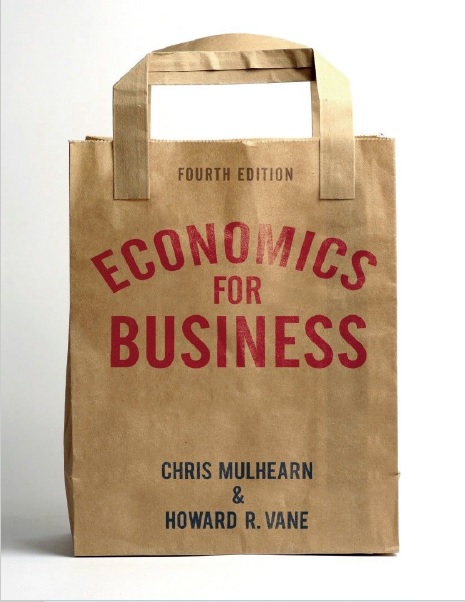Economics for Business, Fourth Edition
By Chris Mulhearn & Howard R. Vane

Contents:
List of figures and tables
Preface
Guide to the book
Online resources
1 Economics and business
1.1 Introduction: what is economics?
1.2 Why economics matters to business, indeed to everyone
1.3 Understanding the roles of firms, consumers and government in markets
1.4 Scarcity, choice and opportunity cost
1.5 Opportunity cost and incentives
1.6 Microeconomics, macroeconomics and business
1.7 Positive and normative economics
Everyday economics 1.1 answers One thing you should read
2 The market
2.1 Introduction: the market, an old but still very useful institution
2.2 Consumers and demand in the market
2.3 Firms and supply in the market
2.4 The market: bringing demand and supply together
2.5 Applying market analysis 1: the example of economic integration in the European Union
2.6 Elasticity in the market
2.7 Price elasticity of demand
2.8 Determinants of price elasticity of demand
2.9 Why firms need to know about price elasticity of demand
2.10 Applying market analysis 2: OPEC and the market for oil
2.11 Other forms of elasticity
2.12 Markets and asymmetric information
2.13 Markets and the rational consumer
2.14 Markets: concluding remarks
Everyday economics 2.1 answers
One thing you should read
3 The firm
3.1 Introduction
3.2 What do firms do?
3.3 Why is the firm a necessary institution?
3.4 Different kinds of firm
3.5 Reflections on the strategies of firms: profit maximization,
economics and business strategy, organic growth and growth by
merger and acquisition
3.6 Firms’ strategies for survival: resolving the principal–agent
problem, coping with asymmetric information problems
3.7 The death of a firm
3.8 Firms and entrepreneurship: an Austrian view
Everyday economics 3.1 answers
One thing you should read
4 Firms’ costs and revenues
4.1 Introduction
4.2 The short run and the long run
4.3 The short-run production function and the law of diminishing
marginal returns
4.4 Short-run costs
4.5 Production in the long run
4.6 Long-run costs
4.7 Firms’ revenues
4.8 Profit maximization
Everyday economics 4.1 answers
One thing you should read
5 Market concentration and market power
5.1 Introduction
5.2 Market power
5.3 Market structures, market power, price competition and nonprice
competition
5.4 Perfect competition
5.5 Monopoly
5.6 Imperfect competition (also known as monopolistic competition)
5.7 Oligopoly
5.8 Oligopoly and game theory
5.9 Market structures: an institutionalist view
Everyday economics 5.1 answers
One thing you should read
6 Business and government
6.1 Introduction
6.2 Market failure
6.3 Public goods
6.4 Externalities
6.5 Public goods, externalities and business
6.6 The liberal view: market failure and state failure
6.7 Privatization
6.8 Competition policy
6.9 Industrial policy
Everyday economics 6.1 answers
One thing you should read
7 Factor markets
7.1 Introduction
7.2 The labour market
7.3 The demand for labour
7.4 The supply of labour
7.5 Issues in the labour market: bringing demand and supply together
7.6 Factor incomes and economic rent
Everyday economics 7.1 answers
One thing you should read
8 The macroeconomy, macroeconomic policy and business
8.1 Introduction: the macroeconomic context of business
8.2 Economic growth
8.3 Unemployment
8.4 Inflation
8.5 The balance of payments
8.6 A brief overview of macroeconomic policy since 1945
Everyday economics 8.1 answers
One thing you should read
9 Unemployment: causes and cures
9.1 Introduction: the debate over the causes and cures for
unemployment
9.2 The classical approach
9.3 The orthodox Keynesian approach
9.4 The monetarist approach
9.5 The new classical approach
9.6 The new Keynesian approach
9.7 A case study: unemployment in Europe
Everyday economics 9.1 answers
One thing you should read
Appendix: An alternative presentation using an Aggregate Demand
(AD)–Aggregate Supply (AS) model
10 Inflation: causes and cures
10.1 Introduction: the inflation debate
10.2 The monetarist view
10.3 The non-monetarist view
10.4 A case study: maintaining price stability in the euro area
10.5 Concluding remarks
One thing you should read
Appendix: Keynesians, monetarists and new classicists and the
expectations-augmented Phillips curve
11 Economic growth and business cycles
11.1 Introduction
11.2 Economic growth: an overview
11.3 The Solow growth model
11.4 The new endogenous growth models
11.5 Wider influences on economic growth
11.6 Main features of business cycles
11.7 The debate over the cause and control of business cycles
11.8 Concluding remarks
One thing you should read
Appendix: The Solow growth model
12 Stabilizing the economy
12.1 Introduction
12.2 Discretionary policy and policy rules
12.3 The rules versus discretion debate: problems of stabilization
policy
12.4 Changing views on stabilizing the economy
12.5 Concluding remarks
One thing you should read
13 International trade
13.1 Introduction
13.2 The theory of comparative advantage
13.3 Reflecting on comparative advantage: further developments in trade theory
13.4 Patterns of trade since 1945
13.5 International trade policy
Everyday economics 13.1 answers
One thing you should read
14 The balance of payments and exchange rates
14.1 Introduction
14.2 The balance of payments accounts
14.3 The balance of payments and business
14.4 Exchange rates and exchange rate determination
14.5 Exchange rate systems
14.6 Exchange rate systems in practice
14.7 The euro
14.8 The balance of payments, exchange rates and business
Everyday economics 14.1 answers
One thing you should read
15 Globalization
15.1 Introduction
15.2 What is globalization?
15.3 How far has globalization progressed?
15.4 What are the attractions of globalization?
15.5 What threats might globalization pose?
15.6 On reflection, how new is globalization anyway?
One thing you should read
Glossary
Index
